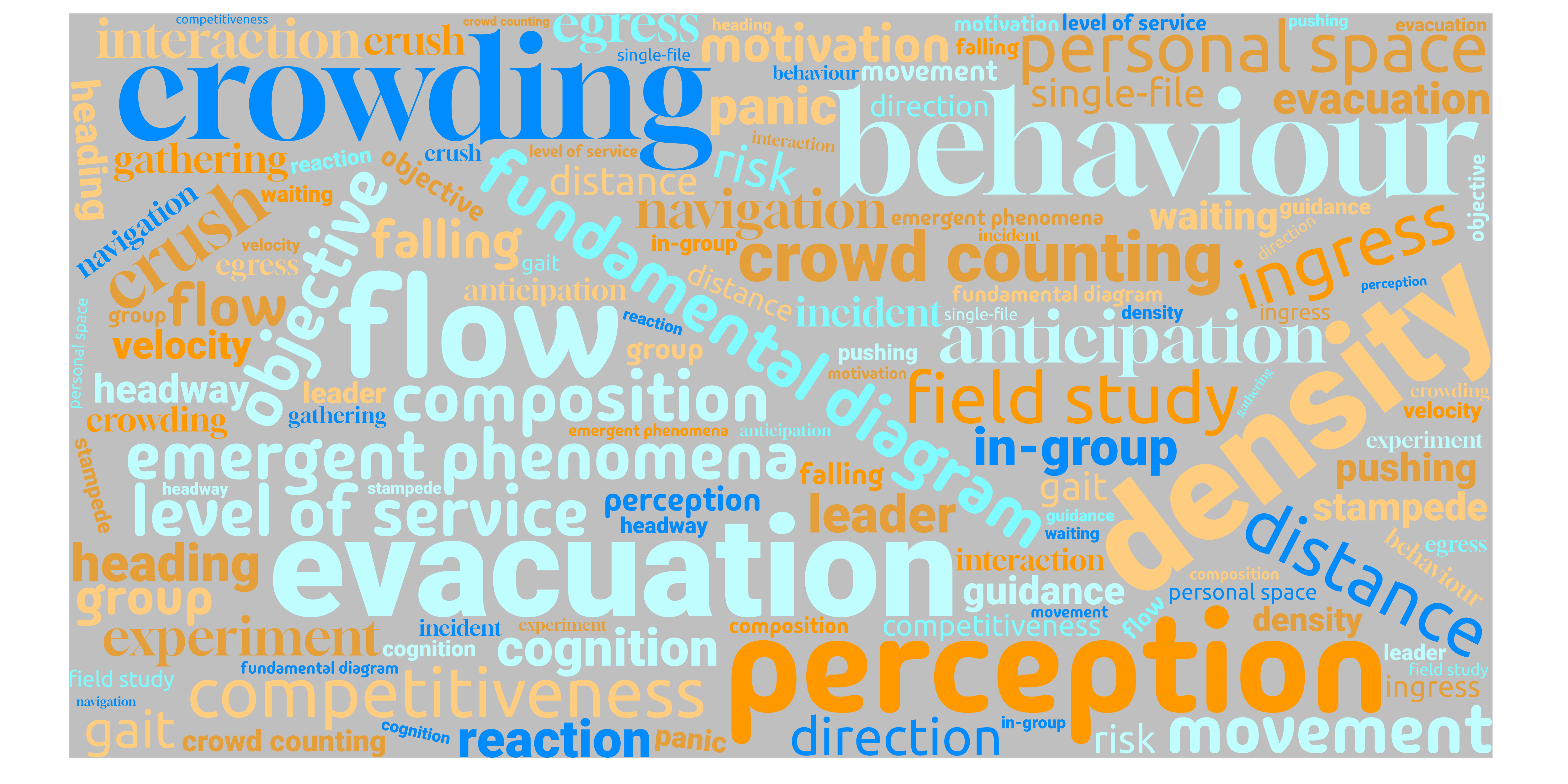Glossary for Research on Human Crowd Dynamics - 2nd Edition
DOI:
https://doi.org/10.17815/CD.2025.189Keywords:
Anticipation, Behaviour, Behavioural repertoire, Behavioural uncertainty, Behaviour (Collective), Behaviour (Operational/Tactical/Strategic), Behaviour (Rational), Behaviour (Non-rational), Behaviour (Irrational), Behaviour detection, Pushing behaviour, Bottleneck, Cognition, Cognitive maps, Competitiveness, Crush, Crowd composition, Crowd incident, Crowding, Density, Distance, Egress, Egressibility, Emergent phenomena, Evacuation, Evacuation guidance, Experiment, Falling, Falls, Field study, Flow, Flow rate, Fundamental diagram, Gait analysis, Gathering (Crowd/Mass/Religious), Group, Groupthink, In-group, Social group, Prototypical group member, Headway, Ingress, Interaction, Leader, Level of service, Model (Hybrid), Model (Machine learning), Movement direction, Heading, Motivation, Navigation, Objective, Target, Purpose, Goal, Panic, Pedestrian, People counting, Perception, Risk perception, Personal space, Response time, Single-file, Single-file motion, Stampede, Trajectory, Velocity, Observed velocity, Free velocity, Desired velocity, Waiting, Zipper effectAbstract
Pedestrian and crowd dynamics involves multiple disciplines, including computer science, engineering, mathematics, physics, bio-mechanics, psychology, social science and more. For effective collaboration between disciplines, researchers need a common understanding of key concepts. To address this challenge, A Glossary for Human and Crowd Dynamics was published six years ago, providing researchers with a valuable reference for cross-disciplinary communication.
We now present the second version, which includes 53 new concepts and 12 revisions from the first glossary, collaboratively developed by 65 contributors from various disciplines and regions around the world through a multi-stage process. This process involved identifying new concepts not covered in the first glossary and suggesting revisions to existing entries, voting on proposed additions and modifications, writing definitions for the selected concepts, and collaboratively revising and editing the entries.
By introducing new terms and refining existing definitions, this glossary aims to facilitate clearer communication, improve conceptual consistency, and support collaboration among researchers working within the field of human and crowd dynamics from diverse perspectives.
References
Adrian, J., Bode, N., Amos, M., Baratchi, M., Beermann, M., Boltes, M., Corbetta, A., Dezecache, G., Dezecache, G., Drury, J., et al.: A glossary for research on human crowd dynamics. Collective Dynamics 4, 1–13 (2019). doi:10.17815/CD.2019.19

Downloads
Published
How to Cite
Issue
Section
License
Copyright (c) 2025 Juliane Adrian, Martyn Amos, Cécile Appert-Rolland, Mitra Baratchi, Nikolai Bode, Maik Boltes, Thomas Chatagnon, Mohcine Chraibi, Alessandro Corbetta, Arturo Cuesta, Guillaume Dezecache, John Drury, Iñaki Echeverría-Huarte, Sina Feldmann, Claudio Feliciani, Lazaros Filippidis, Zhi-Jian Fu, Paul Geoerg, Roland Geraerts, Rhea Haddad, Milad Haghani, Gesine Hofinger, Nick Hopkins, Pavel Hrabák, Aoife Hunt, Xiaolu Jia, Max Kinateder, Angelika Kneidl, Krisztina Konya, Gerta Köster, Laura Künzer, Mira Küpper, Peter Lawrence, Ruggiero Lovreglio, Jian Ma, Fergus Neville, Alexandre Nicolas, Katsuhiro Nishinari, Evangelos Ntontis, Anne-Hélène Olivier, Daniel Parisi, Julien Pettré, Tom Postmes, Kalaga Ramachandra Rao, Enrico Ronchi, Andreas Schadschneider, Jette Schumann, Sebastián Seriani, Armin Seyfried, Anna Sieben, Michael Spearpoint, Gavin Brent Sullivan, Anne Templeton, Peter Thompson, Akiyasu Tomoeda, Antoine Tordeux, Claudia Totzeck, Ezel Üsten, Natalie van der Wal, Ashish Verma, Nanda Wijermans, Zeynep Yücel, Francesco Zanlungo, Jun Zhang, Iker Zuriguel

This work is licensed under a Creative Commons Attribution 4.0 International License.
Authors contributing to Collective Dynamics agree to publish their articles under the Creative Commons Attribution 4.0 license.
This license allows:
Share — copy and redistribute the material in any medium or format
Adapt — remix, transform, and build upon the material
for any purpose, even commercially.
The licensor cannot revoke these freedoms as long as you follow the license terms.
Authors retain copyright of their work. They are permitted and encouraged to post items submitted to Collective Dynamics on personal or institutional websites and repositories, prior to and after publication (while providing the bibliographic details of that publication).








